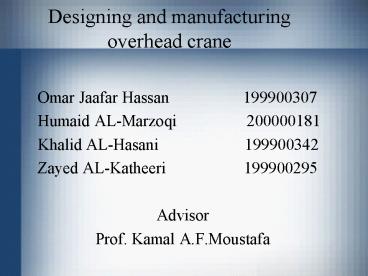Designing and manufacturing overhead crane - PowerPoint PPT Presentation
1 / 40
Title:
Designing and manufacturing overhead crane
Description:
... Approach Cont. State Variable Form State Space Form MAT-LAB ... Cont. Lagrange s Approach Cont. State Variable Form State Space ... – PowerPoint PPT presentation
Number of Views:2231
Avg rating:3.0/5.0
Title: Designing and manufacturing overhead crane
1
Designing and manufacturing overhead crane
- Omar Jaafar Hassan 199900307
- Humaid AL-Marzoqi 200000181
- Khalid AL-Hasani 199900342
- Zayed AL-Katheeri 199900295
- Advisor
- Prof. Kamal A.F.Moustafa
2
Crane Mechanism
3
Materials Handling
- 1) Picking up the load
- 2) Transporting the load
- 3) Setting the load down
4
Importance of cranes
- 1.Avoid Congestion, Delays and unnecessary
handling.2. Improve production operations . - 3. Lower unit Materials handling Cost
5
Importance of cranes cont.
- 4. Reduce damage due to Materials handling.
- 5. Maximize space utilization.
- 6. Reduce the accident rate and severity of
injury.
6
Type of cranes
- Mobile cranes
- Stationary cranes
7
Mobile cranes
- Mounted Cranes
- Crawler-Mounted Cranes
8
Mounted Cranes
A wheel-mounted crane is mobile and flexible
crane that can be driven on or off roads over
rough terrain. Advantage small working area.
9
Crawler-Mounted Cranes
Stable base. The advantage continuous work in
remote areas
10
Stationary cranes
- Bridge Cranes
- Jib Cranes
- Gantry cranes
- Tower Cranes
11
Bridge Cranes
- The most important part are girders, trucks, end
ties, walkway and a drive mechanism
12
Jib Cranes
- Jib cranes consist of a horizontally mounted
beam, not unlike a monorail, but that can swing
in a semi-circle.
13
Gantry cranes
- Bridge crane but with girders that used in free
space.
14
Tower Cranes
- Construction crew uses the tower crane to lift
steel, concrete, large tools.
15
Main Components of Overhead Crane
- Girder
- Trolley
- Hoist
- Runway Rail
16
(No Transcript)
17
Safety
- Safety instruction
- Steps to inspect the crane safety
- Maintenance of the overhead crane
18
Safety Instructions
- Loads should not be suspended over personnel
below. - Avoid rapid movements in any direction
19
Safety Instructions
- Do not exceed the rated load capacity of the
crane, hoist, chain, cable, slings, or other
component.
20
Steps to inspect the crane safety
- Daily inspection
- Periodic inspection
21
Daily inspection
- Hoisting and lowering
- Trolley travel
- Bridge travel
22
Periodic Inspections
- Deformed, cracked or corroded members
- Loose bolts or rivets
- Cracked or distorted parts such as bearings,
gears, rollers, etc - Excessive wear on brake system parts
23
Maintenance Requirements
- A preventive maintenance program based on the
crane manufacturers recommendations must be
implemented. - Only specialist engineer may perform the required
maintenance and repairs.
24
Procedure of designing
25
Designing Techniques
- Newtons Second Law approach
- Lagranges approach
26
Newtons Second Law approach
- Assumptions
- Cable is mass less
- The payload is lumped with the hook and
- modeled as a sphere
- The system is frictionless
27
Newtons Second Law approach cont. Free body
diagram of the system
28
Newtons Second Law approach cont. Trolley
kinetic
29
Newtons Second Law approach cont. Payload
kinetics
Force balance in the horizontal direction
30
Newtons Second Law approach cont. Payload
kinetics
Force balance in the vertical direction
31
Lagranges Approach
32
Lagranges Approach Cont.
Kinetic energy expression
Potential energy expression
33
Lagranges Approach Cont.
34
State Variable Form
35
State Space Form
36
MAT-LAB Representation
37
Force Behavior
38
Displacement Behavior
39
Velocity Behavior
40
Swing Behavior































